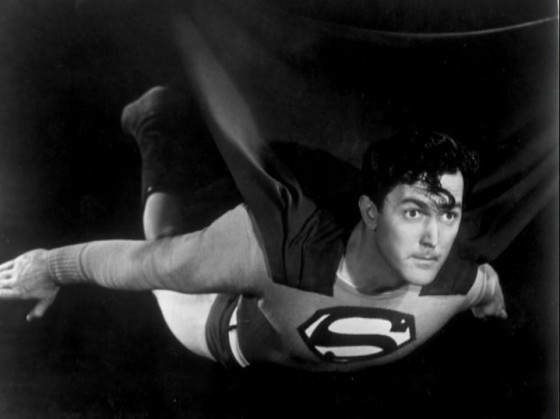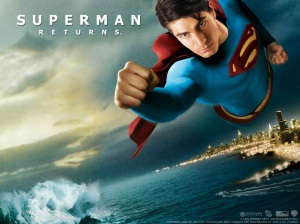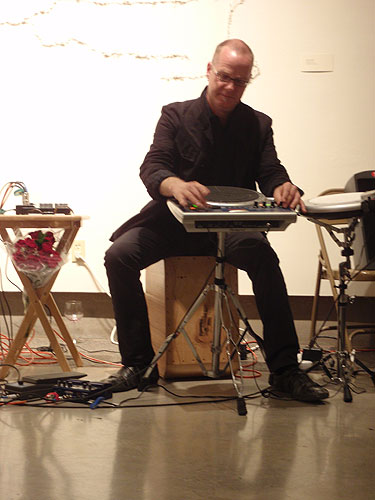Review of Superman Returns
(originally posted 6/30/2006)
Has ever a director/producer spoken so directly to his audience as Bryan Singer does through Superman (Brandon Routh) in his movie Superman Returns? As Superman holds Lois Lane (Kate Bosworth) close to him high above Metropolis, he says, “You wrote that the world doesn’t need a savior, but every day I hear people crying for one.”
It was clearly Singer who heard this nation’s cry for exactly that, and in true Hollywood style, he took the cries he heard about the problems facing this country and the world, the things that are “society’s broken bones” and, to quote film critic Tay Fizdale, “stuck a band-aid on them.”
That’s not to belittle Singer’s efforts at all. The last time we saw Superman on the big screen was in the thick of the Cold War. The U.S., and indeed the world, cowered under the possibility of nuclear war. Who didn’t wish that some higher power would come and rid the planet of these horrific weapons, and that’s exactly what 1987 Superman IV director Sidney J. Furey had Superman do. Unflinchingly, writer Mario Puzo’s Superman (Christopher Reeve) said, “I fight for truth, justice and the American way!”
Singer is doing an admirable job of addressing our modern fears in the same manner, though you won’t hear the words, “the American way” in his film. When Perry White (Frank Langella), Editor in Chief of the Daily Planet, is addressing his staff, he charges them with finding out whether Superman still stands for “truth, justice…all that stuff.”
Clearly Singer, who also wrote the screenplay, couldn’t stomach the words “the American way” coming out of any of his characters’ mouths, which gives us a clue about the real question posed by this movie’s arrival on the scene. It’s not, “Why does Metropolis need Superman to return now?” It’s clearly, “Why doesAmericaneed this film franchise to return to the big screen at this particular time?”
It seems Superman has always had a good sense of when to land in movie theaters. He first appeared on the silver screen in 1948, played by Kirk Alyn, in two serials produced by Columbia Pictures Superman and Superman Versus Atom Man. This places his original big screen debut just three years after the end of World War II. America, through its engineers’ genius, having harnessed forces far greater than ever imagined in the atomic bomb, was perhaps feeling smaller and questioning its own wisdom more than ever before.

Kirk Alyn played Superman in the late 1940's in two Columbia Pictures serials Superman and Superman Versus Atom Man
Enter Superman, an energetic Alyn, to remind the generations of the 40’s and 50’s what being an American was really all about. As movies are designed to do, Columbia’s Superman serials let viewers escape, if only for an hour or so, from the dark clouds of reality. That escape, however, was tempered with enough pertinence to real world events to keep the movie relevant. After all, who was Superman’s nemesis in the second serial? ATOM Man. A coincidence? With such appealing movies, who cared to ask?
When the Vietnam War broke America’s heart again in the 60’s and 70’s, Superman was soon to be found on the scene, and the big screen. Veterans of the conflict had watched their fathers and uncles come home from Koreaas heroes, but they themselves were greeted with cries of “Babykiller!” Those involved in the protest movement were wondering why it had taken their government years to respond to them, how their voices could have been ignored for so long. After fifteen years of strife, bewildered and divided Americans had a common legacy: exhaustion.
True to form, Superman showed up just three years later in the 1978 Warner Brothers production Superman: The Movie. Super villains General Zod (Terrance Stamp), Ursa (Sarah Douglas) and Non (Jack O’Halloran) used the term “regime” to describe the system they would use to rule Superman’s home planet Krypton. Americans were all too familiar with that term, and didn’t blame Superman’s father Jor-El (Marlon Brando) or the judicial council on which he sat for banishing the evil trio from Krypton. In Superman: The Movie and in the 1981 Superman II, both written by Mario Puzo (who also wrote the screenplay for The Godfather), Superman dispatched villains who were unquestionably evil. As before, Superman’s dealings with these criminals provided a relevance to reality, with just enough escape from it to spell relief.
To Americans struggling for clarity and identity after the demoralizing war in Vietnam, such a black and white presentation of good and evil refreshed them. Lex Luthor (Gene Hackman) and his self-interested plot to blow the West Coast off the map pulled the eyes of 70’s audiences away from their tattered vision of Americaand focused them squarely on someone who was easy to hate. In Superman II, the return of Zod and his wicked companions brushed subtly closer to the issues at hand (global supremacy, threatening ideologies) but reassured Americans that regardless of what America was, it was not a “regime.” It couldn’t possibly be as bad as those they’d been fighting against. Superman was here to say so!
Superman’s cinematic “band-aids” couldn’t heal society’s wounds, but they did ease the sting for a little while. Thus in his very failure to save America from its real fears outside the movie theater, Superman assured his continued success in it with two more movies emerging before 1988. Clearly, the country needed another dose of his vaccine against the loss of national identity.
In the 1983 Superman III, he tackled the nation’s issues more head-on than ever before when he became evil under the influence of the synthesized kryptonite given to him by Gus Goreman (Richard Pryor). As the evil side of Superman split from the good side, represented by Clark Kent, and the two identities began to battle each other in the abandoned junkyard, 80’s audiences might as well have been watching their own eroding trust in “the American way” and America’s rights and responsibilities in the world. Of course, Superman’s good side triumphed and reemerged as strong and pure-hearted as ever. If only America could have felt its own redemption so swiftly and completely. If only a real Superman could have wiped the world clean of nuclear weapons as Hollywood’s Superman did in 1987. Instead, fears over the atomic bomb, its implications, America’s humanity remained untouched, continuing to plague the national conscience forty years after the wholesome hero’s arrival on the big screen.
And now, almost twenty years later, Superman has spotted us plunging in an ideological freefall once again. With the last two presidential elections painting a picture of a country more divided than ever, and popular support for the current administration at an all-time low, is it any wonder that with 2006 comes a new Superman swooping in to catch us and place us safely in a theater seat? Luthor, played by Kevin Spacey in Superman Returns, is as easy to hate as ever in his selfish plot to flood the entire U.S., killing “billions of people” and establishing himself as the sole proprietor of the new land mass he’s going to create. It seems the perfect evil plot, especially since he’ll be growing his new continent from the crystals Jor-El placed in Superman’s escape pod from Krypton combined with some kryptonite that’s been hanging around in the Metropolis museum since 1978.
Will Superman let him get away with it? Not likely, but it will be a tough job for the Man of Steel, since the very ground Luthor stands on was created by, and is infused with, the one substance that can rob Superman of all his powers. Still, we’ll all be there again to cheer our hero on! Though Singer can’t bring himself to include the phrase “the American way” in his script, it is still part of what we’ve all come to recognize as an integral piece of Superman. Even at a time like this when the divided nation can no longer put its finger on just what is the American way, we still want to believe in it. This is evidenced by the fact that the movie has been number one at the U.S.box office since its release on Wednesday, June 28, with a five-day domestic gross of nearly $85,000 as of Sunday July 2.
Though it may not seem so, my hat is off to Singer for bringing Superman back into our lives in 2006. Just as his hero speaks directly for Singer in the earlier scene withLois Lane, it is Lois herself who speaks for all of us later in the film. Her fiancé Richard White (James Marsden) asks, “Were you in love with him?” An emotional Lois replies, “He was Superman. Everyone was in love with him.”
And, evidently, we still are.
Sources:
Harrington, Wallace, Synopsis/Review: Superman: The Movie, Superman II, Superman III & Superman IV, Superman Homepage, http://www.supermanhomepage.com/movies.php
Smith, Andrew A., CAPTAIN COMICS: A Glance at the Various Superman Presentations, Scripps Howard News Service, http://www.sacbee.com/24hour/entertainment/books/news/story/3318725p-12224719c.html
Tistaert, Lee, Daily Box Office, Weekend Box Office, Lee’s Movie Info, http://www.leesmovieinfo.net/BoxOffice.php
The Vietnam War, The History Place, http://www.historyplace.com/unitedstates/vietnam/index.html
World War Two in Europe, The History Place, http://www.historyplace.com/worldwar2/timeline/ww2time.htm#1945





